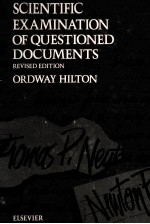图书介绍
SCIENTIFIC EXAMINATION OF QUESTIONED DOCUMENTS REVISED EDITIONPDF|Epub|txt|kindle电子书版本网盘下载

- ORDWAY HILTON 著
- 出版社: INC.
- ISBN:0444006281
- 出版时间:1982
- 标注页数:424页
- 文件大小:102MB
- 文件页数:438页
- 主题词:
PDF下载
下载说明
SCIENTIFIC EXAMINATION OF QUESTIONED DOCUMENTS REVISED EDITIONPDF格式电子书版下载
下载的文件为RAR压缩包。需要使用解压软件进行解压得到PDF格式图书。建议使用BT下载工具Free Download Manager进行下载,简称FDM(免费,没有广告,支持多平台)。本站资源全部打包为BT种子。所以需要使用专业的BT下载软件进行下载。如BitComet qBittorrent uTorrent等BT下载工具。迅雷目前由于本站不是热门资源。不推荐使用!后期资源热门了。安装了迅雷也可以迅雷进行下载!
(文件页数 要大于 标注页数,上中下等多册电子书除外)
注意:本站所有压缩包均有解压码: 点击下载压缩包解压工具
图书目录
PART Ⅰ INTRODUCTION AND BASIC DEFINITIONS1
1 Preliminary Considerations3
Documents and Questioned Documents3
Examiner of Questioned Documents4
Standards6
Reference Collections6
Instruments7
Scientific Examination of Documents8
Probability of Accidental Coincidence9
Nonidentity of Source10
Natural Variation10
The Opinion11
Basis of Effective Court Presentation11
Indefinite Findings12
Scope of Document Problems12
2 Definitions of Terms14
General Terms15
Handwriting18
Typewriting22
Altered Documents24
Other Identification Problems25
Photographs and Other Reproductions27
PART Ⅱ WHAT EXAMINATION OF A DOCUMENT MAY REVEAL31
3 Instruments and Materials Used to Prepare Documents33
The Pen33
Writing Inks39
Pencils42
Crayons and Marking Pencils46
The Typewriter46
Computer Printouts57
Carbon Copies58
Typewriter Ribbons61
Correction Liquid and Paper65
Adding Machines, Calculators, and Cash Registers66
Mechanical Recording Devices68
Check Writers69
Hand and Impression Stamps71
Mimeograph and Office Duplicating Methods76
Address Stencils and Plates78
Printed Matter79
Paper Examination82
Carbon Paper88
Seals and Authenticating Devices90
Adhesive Stamps91
Grouping and Binding Devices91
Conclusions94
4 Alterations in Documents95
Erasures96
Associated Evidence106
Cutting106
Interlineations and Additions108
Obliterated or Smeared-over Writing117
Altered Photocopies122
Proof of an Unaltered Document122
Conclusions124
5 Damaged Documents125
Damage and Obliteration by Water125
Light-Faded Inks126
Stained Documents130
Torn Documents131
Charred Documents132
Conclusions134
6 Accidental Markings and Impressions on a Document135
Latent Fingerprints135
Writing Offsets138
Impressed Writing138
Foreign Traces141
Conclusions142
7 Additional Clues for the Investigator143
Indicative Information143
Illegible Handwriting146
Blank Papers146
Secret Inks148
Ballot Frauds148
Conclusions149
PART Ⅲ DISCOVERY OF FACTS BY COMPARISON WITH KNOWN MATERIAL151
8 Identification of Handwriting153
Writing Forms and Qualities154
Arrangement of Writing158
Writing Variation158
Class and Individual Characteristics160
Identification in a Practical Situation160
Nonidentity of Writings161
Typical Problems Involving Writing Identification162
Holographic Wills165
Inhibiting Factors168
Disguise168
Conclusions171
9 Identification of Signatures and Detection of Forgery172
Genuine Signatures173
Unusual Genuine Signatures176
Detection of Forgery182
Forgery of Holographic Documents192
Identifying the Forger199
Assisted or Guided Signatures202
Identification of Initials and Illiterates' Marks204
Conclusions207
10 Identification of Handlettering and Numerals210
Handlettering210
Numerals217
Conclusions223
11 Typewriting Identification224
Printing Defects226
Machine Defects228
Variation229
Transitory Defects231
Basis of Identification233
Typebar Machine233
Proportional Spacing Typewriting235
Single Element Type Ball Machines237
Proportional Spacing Single Element Machines243
The Electronic Typewriter246
Identification Problems248
Identification of the Typist250
Identification by Typewriter Ribbon252
Forgery of a Typewriter255
Disguised Typewriting258
12 Other Mechanical Impressions, Including Check Writers and Printing Identifications260
Check Writers and Check-Writing Units260
Adding-Machine Tapes and Cash-Register Receipts262
Other Recording Machines264
Computer Printouts266
Time Clocks and Date Stamps266
Printed Matter268
13 Age of a Document273
Dating by Materials274
Dating by Changes in Materials280
Dating by Comparison282
Dating by Chance Marks291
Combination of Factors294
Conclusions295
PART Ⅳ THE ATTORNEY-INVESTIGATOR'S ROLE IN A QUESTIONED DOCUMENT PROBLEM297
14 Preparation and Collection of Handwriting Standards299
Collected Standards299
Sources of Standards308
Request Standards310
Special Considerations for Request Signatures320
Combination of Request and Collected Standards321
Standards for Special Problems322
Standards Prepared Under Cross-examination327
Handlettered Standards328
Conclusions329
15 Typewriting Standards331
Standards for Machine Identification331
Single Element Standards343
Standards to Identify the Operator346
Conclusions348
16 Care,Handling,and Preservation of Documents349
Protcctive Enveelopes350
Earlv Submission for Examination350
Proper Storage351
Avoid Excessive Handling352
Do Not Mark353
Do Not Fold,Cut,or Tear355
Do Not Allow "Amateur" Testing357
Charred Documents359
Conclusions360
17 Reproduction of Documents361
Photographs362
Today's Dry-Photocopying Systems369
Earlier Reproduction Methods373
Other Methods379
Analysis of Photocopies384
Fraudulent Photocopies385
PART Ⅴ THE DOCUMENT PROBLEM GOES TO COURT389
18 Preparation for Trial391
The Document Examiner's Preparation391
Special Reports and Conferences399
19 In the Court Room403
Proofof Standards403
The Document Examiner's Testimony404
Purpose of the Doc ument Examiner in Court413
Document Examiners as Opposing Witnesses413
Use of More than One Expert Witness414
Affidavits and Depositions by Document Examiners415
Conclusions416
Index417